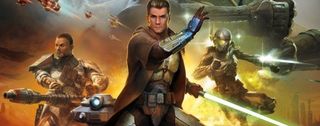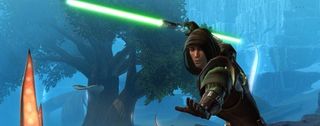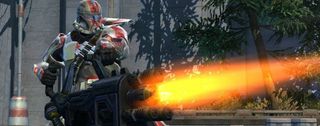How Bioware wrote Star Wars: The Old Republic

The most ambitious aspect of Star Wars: The Old Republic is the staggering amount of writing involved. Every class has their own storyline that unfolds over dozens of hours. Every character you speak to has their own voiced dialogue. It has to be one of the biggest writing projects undertaken by a game studio. How on earth did Bioware do it? We spoke to lead writer Daniel Erickson to find out.
The actual dialogue that you hear when playing is decided much later than you might think, and is the result of long, vigorous writing process that sees ideas tossed back and forth between Bioware's writers, world designers, artists and animators. It all starts simply, though, with a series of short stories.
"It starts with the plot summary which is very much like a story idea pitch," says Erickson. "That's written very much like a classic story - they're going to do that in word and paragraph and whatever... We're gonna go through that, we're gonna see if it's just a good story in general? Does it have the right things that you need for a Star Wars story: are there great characters? Are there great twists? Is it overly predictable?"
Once a narrative has been decided, it has to be applied to the MMO format. There are plenty of logistical questions that need answers before any writing can begin. How many NPCs will be needed to tell the story? How many conversations do they need to have? What do they have to communicate in each one? All of this gets decided in a series of detailed design documents. Erickson tells us that "the idea for the design document version of it is that if we had to hand it to a different writer they could do it and, although the words would be different, it would generally come out about the same."

After that, each story line gets passed back and forth between the writers, artists and animators. A line like "and then a the annoying Gungan is hurled face first into an exploding sun" is easy to write, but technically almost impossible to realise. It's initially up to the world designers to help decide what is and isn't going to work.
"They go through with a fine-toothed comb and look at everything that's required," Erickson explains. "They look at the pacing, and look at how it would feel in the world, and they're gonna give us feedback and say, "this whole scene here where you have 700 people here, and they're all going to fly in the air and then get juggled and then turn into tarantulas? We don't have a way to do any of that."
"Then it's gonna go to the cinematic team, it's gonna go to the art team - they're gonna look at all the requirements, everybody gives their thumbs up, and then the writers start writing."
The biggest gaming news, reviews and hardware deals
Keep up to date with the most important stories and the best deals, as picked by the PC Gamer team.
Then all that's left to is write hundreds of hours of dialogue. This is not straightforward. The world design team go through every story arc, inserting quick "greyboxes," tagged with the technical scripting information needed to wire the quests together, along with quick lines of dialogue that communicate the essence of what's being said in the conversation.

Erickson describes the process. "Let's say the quest is to go defeat this guy - you'll have the conversation and then the guy standing next to him. So he'll be like, "you must go and, you know, journey across the many mountains and the long thing to defeat this guy. Well in the greybox you can just turn and be like, "bam, you're dead!" and then come back to him and have a return conversation."
At this stage, the team can see the back and forth of each conversation as it would appear in-game. "There's a lot of editing done at that point. Then after that, we drop it in the real game, and people play it in a real space. They figure out what the actual pacing is between gameplay and story, whether it slows, whether it's sensible."
"James [Ohlen, game director] at that point is usually going to come in and - that's really when he's going to get in there and give his critiques. We're gonna polish that up. Once all of that is signed off, we're gonna send it off to be recorded."
Apart from the scale of the project, the writing methods don't differ much from the ones Bioware used to create Mass Effect and Dragon Age, but Erickson mentions being restricted by the technical complexities of an MMO. "We have to be more buttoned up than on a normal project" he says. "We have to be more aware of our technical restrictions and more aware of how the rest of the game works. So, we're not writing things that turn out to be untenable.
"You can teleport people around in a normal RPG, you can fake things, you can make it look like you went from one place to another because there's a secret room hidden in the wall - you can do all sorts of chicanery that, if you tried to do in an MMO somebody's gonna find that room, somebody's gonna teleport out. We have to cheat a lot less, and that takes more time."
Star Wars: The Old Republic went live a week before Christmas. The war between the Republic and the Empire is in full swing. Join us. If you're based in Europe, you'll find The Mint Imperials and The Revel Alliance on Nightmare Lands. In the US, you'll find The Coconut Monkeys on The Crucible Pits.
Part of the UK team, Tom was with PC Gamer at the very beginning of the website's launch—first as a news writer, and then as online editor until his departure in 2020. His specialties are strategy games, action RPGs, hack ‘n slash games, digital card games… basically anything that he can fit on a hard drive. His final boss form is Deckard Cain.
Most Popular






